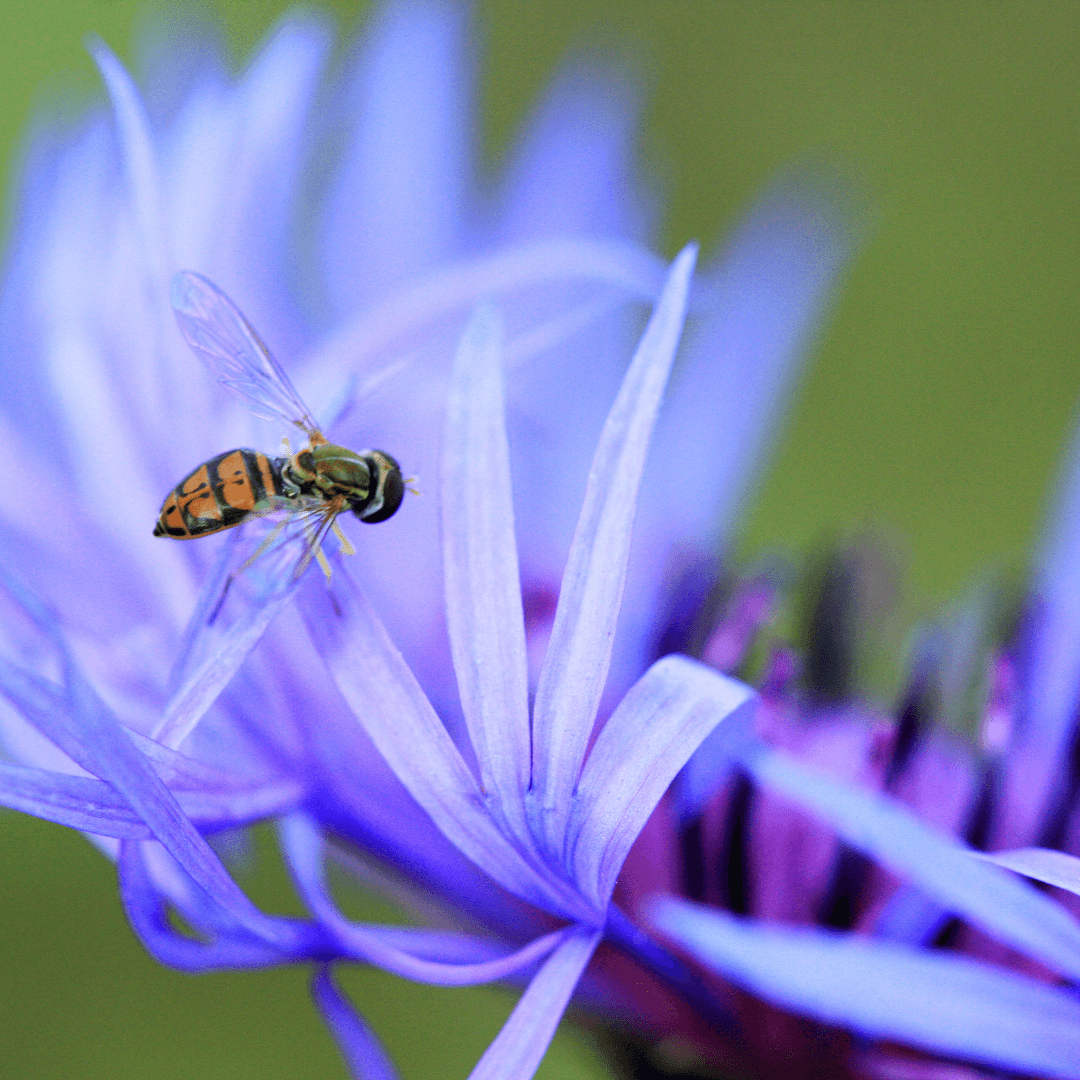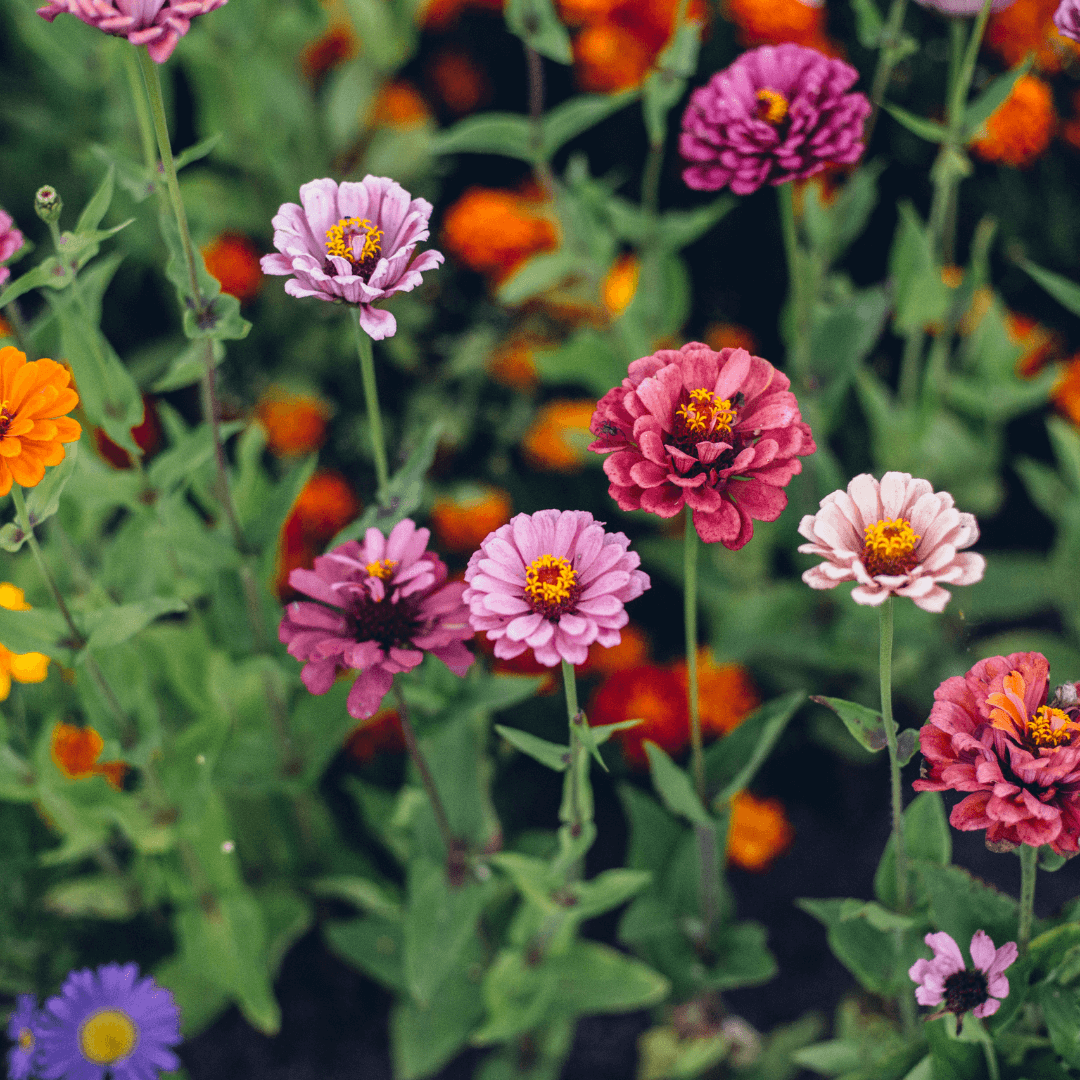Hello, fellow gardeners! My name is Jeena, and I am a passionate gardener who loves sharing my knowledge with others. Today, I will guide you through growing French marigolds, a beautiful addition to any flower garden. With their vibrant colors and intricate double or single flowers, these drought-tolerant plants are perfect for pots, containers, or flower beds in full sun. Let's learn how to grow French marigolds from seeds so you can brighten up your flower garden!
1. Understanding French Marigolds (Tagetes patula)
Before we dive into how to grow French marigolds, let's explore some key characteristics of these lovely flowers.
Plant Characteristics
- History of the Seed: French marigolds are native to Mexico and Central America; they have been cultivated for their ornamental and medicinal properties since ancient times.
- Days till maturity: Approximately 50-60 days from seed to flower
- Planting depth: 1/4 inch
- Plant spacing: 8-12 inches apart
- Days to germination: 7-14 days
- Start indoors or direct sown: Either, but starting seeds indoors can yield better results
- Full sun or partial shade: Full sun
- When to harvest: When the flowers are fully open and vibrant
- How tall does the plant get: 6-18 inches tall
- How wide does the plant get: 8-12 inches wide
- Native: Mexico and Central America
- Family: Asteraceae
Marigold Seeds For Planting | 4 Variety Pack
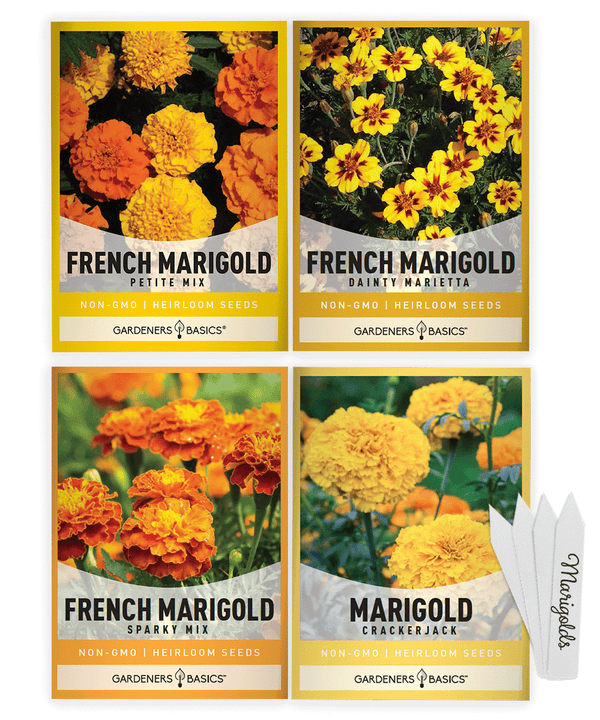
$7.95
4 Heirloom Marigold Varieties for Natural Pest Control and Beautiful Blooms Introducing our 4 Marigold Seeds Variety Pack – the perfect choice for gardeners who love vibrant, resilient blooms! This carefully selected pack includes heirloom seeds that are non-hybrid, open-pollinated,… read more
2. Choosing and Buying French Marigold Seeds
To start growing marigolds must purchase high-quality French marigold seeds. Look for seed packets labeled "Tagetes patula" or "French marigold" from reputable seed suppliers. We have a large selection in our store at Gardeners Basics. You may find different varieties: double, singles, and the smaller signet marigold. Choose the type that best suits your flower garden.
3. Starting Seeds Indoors
To give your French marigolds seeds a head start, sow seeds indoors 6-8 weeks before the danger of frost has passed. This gives your plants enough time to grow strong before transplanting outdoors.
How to Sow Seeds Indoors
- Fill seed trays or small pots with well-draining soil mixes, such as peat moss, vermiculite, and perlite.
- Sow the French marigold seeds by placing them 1/4 inch deep in the soil, and covering them lightly.
- Water the soil gently to avoid dislodging the seeds.
- Place the seed trays or pots in a warm, well-lit area, maintaining a temperature of 65-75°F (18-24°C).
- Keep the soil moist but not soggy to prevent fungal diseases.
- After 7-14 days, you should see the seeds germinate, and seedlings emerge.
4. Transplanting Seedlings Outdoors
Once the danger of frost has passed and your seedlings are at least 2 inches tall, you can transplant them into your flower bed or containers.
How to Transplant Seedlings
- Prepare the planting area by loosening the soil and removing weeds or debris.
- Dig holes approximately 8-12 inches apart, depending on the variety and your desired plant density.
- Carefully remove the seedlings from their trays or not damage the roots.
- Place each seedling in a hole, ensuring the root ball is covered with soil.
- Water the transplanted seedlings thoroughly to help them establish themselves in their new environment.
5. Direct Sowing French Marigold Seeds
If you prefer to direct sow your French marigold seeds outdoors, wait until the danger of frost has passed and the soil has warmed up.
How to Direct Sow Seeds
- Prepare the planting area by loosening the soil and removing weeds or debris.
- Sow the seeds 1/4 inch deep and 8-12 inches apart, depending on the variety and your desired plant density.
- Cover the seeds lightly with soil and water gently to avoid dislodging them.
- Keep the soil moist but not soggy to prevent fungal diseases.
- After 7-14 days, you should see the seeds germinate, and seedlings emerge.
6. Caring for French Marigolds
With your French marigolds planted, it's essential to provide proper care to ensure healthy growth and abundant blooms.
French Marigold Dainty Marietta Seeds
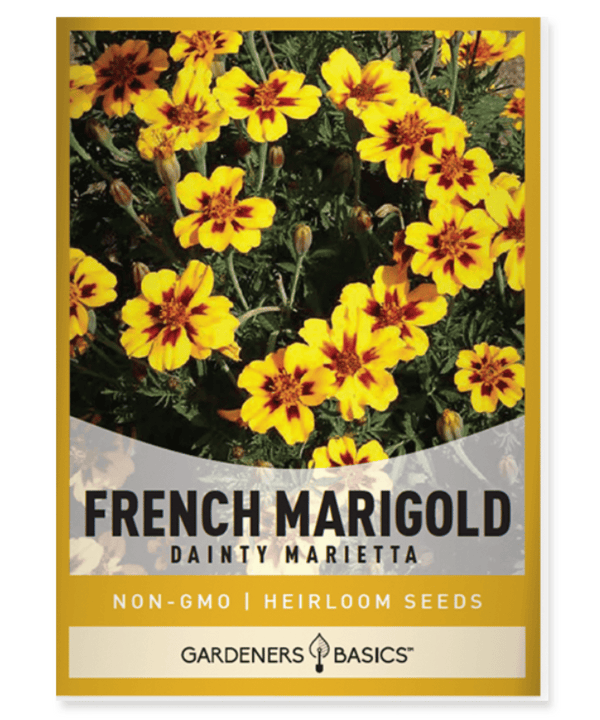
$2.49
Dainty Marietta French Marigold Seeds | Heirloom, Non-GMO, Non-Hybrid, Open-Pollinated Grow stunning Dainty Marietta French Marigolds with our premium-quality seeds! Perfect for flower beds, borders, and containers, these charming marigolds feature vibrant yellow blooms with striking maroon centers, adding a… read more
Watering and Feeding
- Watering: French marigolds are drought-tolerant; they do best when the soil is consistently moist. Water them regularly, especially during dry spells, but avoid overwatering, which can lead to root rot.
- Feeding: Apply a balanced, slow-release fertilizer at planting time and again midway through the growing season to support robust growth and flowering.
Pruning and Deadheading
- Pruning: Pinch back young plants to encourage bushier growth and more blooms. Remove any dead, damaged, or diseased foliage as needed.
- Deadheading: Regularly remove spent flowers to encourage continuous blooming throughout the season.
7. Pest and Disease Control
French marigolds are relatively pest-resistant but can still be affected by spider mites, aphids, and whiteflies. Regularly inspect your plants for signs of pests, and treat with insecticidal soap or neem oil as needed.
Fungal diseases, such as powdery mildew and root rot, can be adequately prevented by watering and adding adequate air circulation around the plants.
8. Companion Planting with French Marigolds
French marigolds make excellent companion plants in the garden, as they help repel pests and attract beneficial insects.
- Vegetables: Plant French marigolds near tomatoes, peppers, eggplants, and potatoes to deter nematodes and other pests.
- Herbs: Basil, mint, and lemon balm can be interplanted with French marigolds to enhance their pest-repelling properties.
- Flowers: Pair French marigolds with other full-sun, drought-tolerant flowers, such as zinnias, cosmos, and salvia, for a vibrant and resilient flower garden.
With this comprehensive guide, you'll be well-equipped to grow beautiful French marigolds in your garden, enjoying their vivid colors and pest-repelling benefits. Learning how to grow marigolds is easy. We hope you will try growing French marigolds in your flower gardens this year. Happy gardening!
 Frequently Asked Questions - How to Grow French Marigolds
Frequently Asked Questions - How to Grow French Marigolds
Q: Can French marigolds be grown in pots or containers?
A: French marigolds can be successfully grown in pots or containers if they have well-draining soil and receive plenty of sunlight. Make sure to choose a container with drainage holes to prevent waterlogging.
Q: How long do French marigolds bloom?
A: French marigolds typically bloom from early summer until the first frost in fall. Regular deadheading can help to encourage continuous flowering throughout the season.
French Marigold Sparky Mix Seeds

$2.49
Sparky Mix French Marigold Seeds – Heirloom, Non-GMO, Non-Hybrid, Open-Pollinated Enhance your garden with the vibrant beauty of Sparky Mix French Marigolds, a stunning heirloom variety known for its fiery blend of orange, red, and yellow hues. These non-GMO, non-hybrid,… read more
Q: Are French marigolds annuals or perennials? Most climates consider
A: French marigolds (Tagetes patuannualsates. Howions may survive and bloom for multiple y in frost-free or very mild-winter regionsears.
Q: Can I save French marigold seeds for next year?
A: You can collect and save French marigold seeds for planting the following year. Allow the flowers to dry on the plant, then carefully remove the seed heads and separate the seeds from the chaff. Store the seeds in a cool, dry place until it's time to plant them again.
Q: Are French marigolds edible?
A: While not as commonly consumed as their relative, the pot marigold (Calendula officinalis), French marigold flowers, and leaves are edible e a slightly spicy or behavior. They can be used as a colorful garnish or added to salads, but it's essential to ensure they are not treated with harmful chemicals before consuming them.
Q: Can I grow French marigolds indoors?
A: Although French marigolds prefer outdoor conditions, it is possible to grow them indoors if you can provide the right environment. They require at least 6-8 hours of direct sunlight, so placing them near a south-facing window or using grow lights is essentiUseo use well-draining soil and a pot with drainage holes to prevent overwatering.
Q: Why are my French marigolds not blooming?
A: Several factors may contribute to French marigolds not blooming:
- Insufficient sunlight: French marigolds need full sun to produce abundant blooms. Ensure your plants receive at least 6-8 hours of direct sun daily.
- Over-fertilization: Excessive nitrogen in the soil can lead to lush foliage at the expense of blooms. Use a balanced, slow-release fertilizer and avoid over-fertilizing.
- Lack of deadheading: Regularly removing spent flowers encourages continuous blooming. Make sure to deadhead your marigolds throughout the growing season.
Q: Are French marigolds toxic to pets?
A: French marigolds are not considered toxic to pets such as dogs and cats. However, it's always best to prevent your pets from chewing on plants, as individual reactions may. Some pets may experience gastrointestinal upset if they consume large amounts of plant material.
Q: How do I overwinter French marigolds?
A: As annuals, French marigolds typically do not survive freezing temperatures. If you live in a mild-winter region, you can try mulching around the base of the plants to protect the roots from cold. Alternatively, you can take cuttings from your marigolds in late summer, root them into and grow them as houseplants over the winter, then transplant them back outside in the spring.



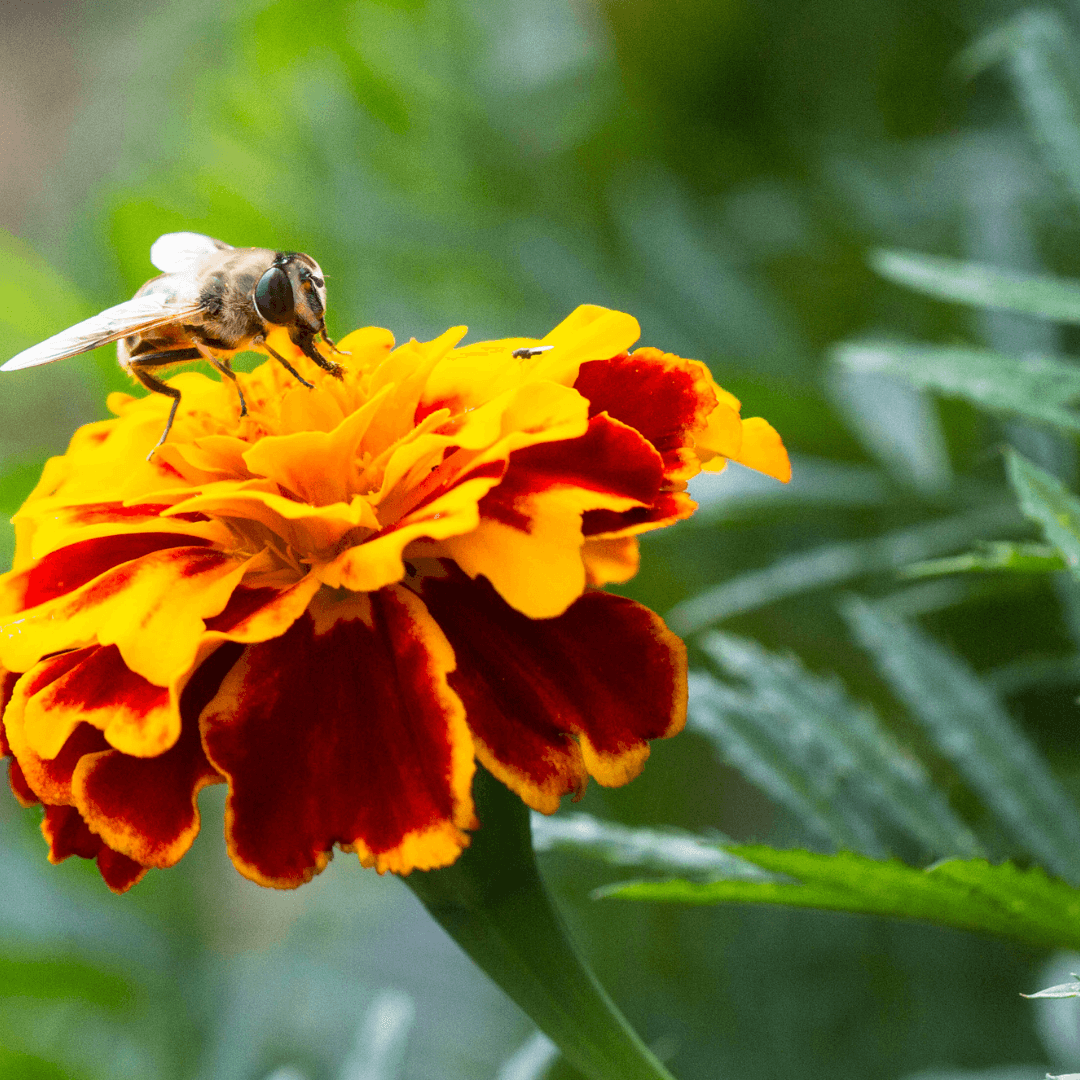

 Frequently Asked Questions - How to Grow French Marigolds
Frequently Asked Questions - How to Grow French Marigolds
